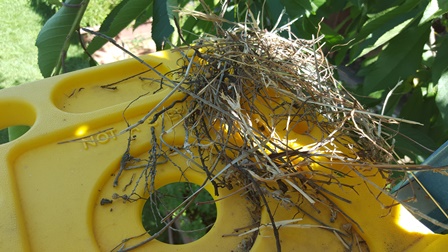Sleuthing Egg Loss and a Nest’s Destruction
What a difference twelve hours makes. When we retired last night, the mourning doves were on their nest atop our tall ladder next to the cherry trees. It was day twelve since the birds built the nest in our garden, so we expected to see babies hatching any day now. Alas, this morning the dove family had fled and there was no sign of eggs or babies.
I believe something raided the nest. It should come as no surprise. Building it on that site seemed like a foolhardy proposition from the start. And to position it on the shelf of the ladder, exposed and near a hole big enough for a chicken egg to fall through seemed a little ridiculous.
And yet, the dove pair dutifully took turns incubating the eggs, even when the mercury hovered at the hundred degree mark on the outdoor thermometer.
In the spirit of helping the family, I kept the fountains filled with fresh water and threw handfuls of birdseed along the stone retaining wall so the pair would have a ready supply of food. Each morning, I’d hurry out to check on the doves before tackling more chores.
When I noticed the nest today and realized it was empty, the eggs were gone, and there was no sight of the doves, I began sleuthing. On the ground near the ladder lay a single long black feather and lots of leaves, knocked from the cherry trees. Not many clues but enough to make a supposition.
I recall that a flock of crows flew in to roost in nearby trees just before dusk last night. They’re both smart and predatory. They’ll raid other nests and eat eggs. I surmised that either they or a local cat or racoon drove away the dove pair and laid waste to the eggs. And yet as I write this, I can see beyond my garden window that a pair of doves are eating the seeds I cast upon the stone wall. Mourning doves can build a nest and lay a set of eggs six times during spring, so there’s still hope.
* * *
If you enjoy reading about wildlife and other topics (including delicious recipes and gardening tips) related to farmette living, check out my cozy mysteries from Kensington Publishing. The first two in the Henny Penny Farmette series are available online at Amazon, Barnes and Noble, Walmart, KOBO Books, and other sites as well as in traditional bookstores everywhere.
BEELINE TO MURDER, see http://tinyurl.com/jo4cxy
MURDER OF A QUEEN BEE, see http://tinyurl.com/zu8s7pf
Paper Wasps Under the Eaves
The small, yellow-striped paper wasps have built two nests under the eaves. These insects are considered agriculturally beneficial, but they tend to get a little too close for comfort. The nests are right above my front door.
The nests are open-cell structures held together by fibers that the queen has masticated from wood posts (and sometimes woody plant stems) and mixed with saliva to create the cells of the nest. The nest can be grow to six to eight inches across in order to accommodate a growing population.
Paper wasps feed their offspring caterpillars, beetle larvae, corn earworms, flies, tobacco hornworms, armyworms, and other insects.
These wasps can sting multiple times, unlike the gentle honeybee that can sting only once. Earlier this year, when we were working on our front windows and door, I was stung four times on my cheek. For people allergic to bee stings, the sting can be life-threatening. It’s recommended to wear a bee suit when removing the nest as the wasps will attack in response to the threat to their nest.
The best time to remove the nest is evening when the wasps are less active and on the nest. High pressure water can be used to knock down the nest. I wrapped a hand towel saturated with a strongly scented kitchen cleaner. I took the nests down and then quickly went back into the house. The next day, a random paper wasp was back, apparently ready to rebuild. What was I to do, but reapply the smelling kitchen cleaner. The wasps are gone now.
 Facebook
Facebook Goodreads
Goodreads LinkedIn
LinkedIn Meera Lester
Meera Lester Twitter
Twitter








